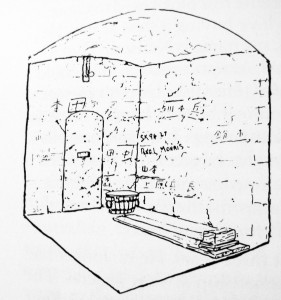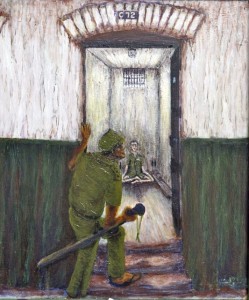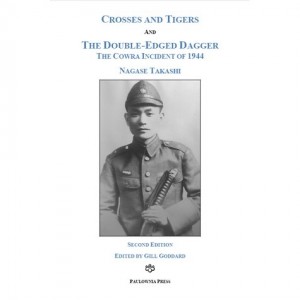PART TWO
ERIC LOMAX & NAGASE TAKASHI –
The Reconciliation Begins
After the war, Eric Lomax returned to Britain a deeply traumatised and troubled man. The phenomenon of post traumatic stress syndrome was not recognised in 1945, although it should have been. During and after World War I, it was known as shell-shock, as the dazed, usually gassed and often maimed survivors of that terrible trench warfare struggled to return to normal life.
In Lomax’s case he had not only endured the hardships of slave labour on the Thai Burma Railway before the discovery of the radio and his map, and subsequent beatings and torture by the brutal Japanese military police, the Kempeitai, but after his court martial he had also had to cope with incarceration in the Kempeitai-run military prison in Singapore, Outram Road Gaol.
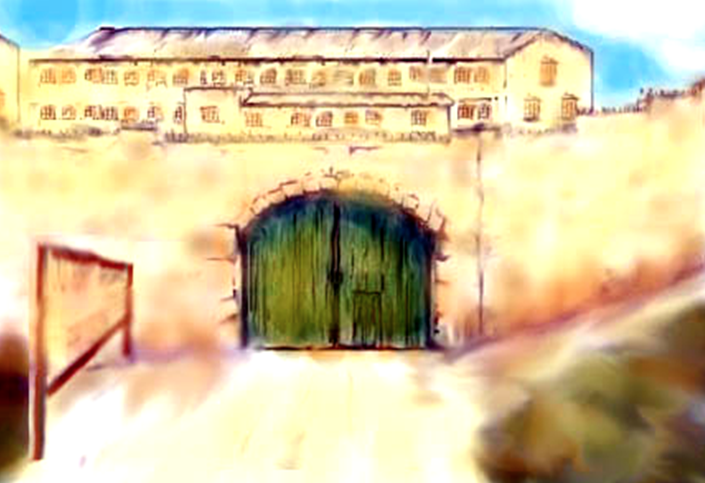
To those prisoners arriving at Outram Road Gaol the first sight were the massive wooden gates in front of the three-tiered block of cramped, tiny cells. (Painting Courtesy of Bill Young)

This was a 19th century gaol built by the British for Asians, where the tiered cells were so small, a Caucasian could touch the walls on either side with his outstretched arms, and barely had room to lie down on the concrete floor. (Painting Courtesy Bill Young)
Outram Road was a place of punishment and executions, where Japanese military wrong-doers were also sent, although they were fed better than the Allied prisoners of war who were doing time there. Conditions there were unspeakable. The Japanese, themselves a fastidious people, deemed that the cells were never to be cleaned and so were verminous and stank. The only things in the cell, other than the prisoner, were three bed boards and a so called wooden ‘pillow’ which could be used at night to separate the emaciated inmate from the concrete floor, a binki [toilet] bucket, often not emptied for weeks, a pair of shorts and a short-sleeved shirt. That was it.
Prisoners were taken out once a week, or fortnight, to the interior courtyard for a so-called wash – where they were allowed to tip a dipper of water over their heads and bodies. A naked light bulb burned day and night, and only a small high barred window let the inmate know whether it was night or day.
Starvation daily rations were about six ounces of rice, some watery cabbage soup, and a small cup of so-called tea. No extra liquid was allowed, so a raging and permanent thirst added to the misery of the prisoners. The food and soup was pushed through a small hinged flap at the bottom of the cell doors, and had to be consumed within 30 seconds, or it was snatched away by guards.
As if that wasn’t bad enough, during the daylight hours the prisoners were not free to move about their limited space, but had to sit on the concrete floor at attention, able to change position every hour with the ringing of a bell. To make sure these rules were obeyed, the guards used to sneak up the corridors wearing felt slippers or rubber-soled boots, to peak in the spy holes in the cell doors to make sure the correct cross-legged position was being maintained. If it was not, they would burst in the door and bash the prisoner with a sword scabbard.
Because the cells were never cleaned, the accumulated filth (and the stench of the un-emptied toilet buckets) attracted vermin, lice and scabies. The scabies, of course, then spread throughout the gaol to the Japanese and Korean guards as well, so weekly scabies baths were added to the ritual of the infrequent washing opportunities. But of course because the cells were never cleaned, re-infections were inevitable. Sometimes the prisoners, driven mad by the dreadful itching of the scabies burrowing under their skin, would scratch themselves raw in a frenzy to get some temporary relief before the cycle happened again.
Some did go mad, either refusing the meagre rations and starving themselves to death, or in several cases, banging their heads against the cell walls till they killed themselves.
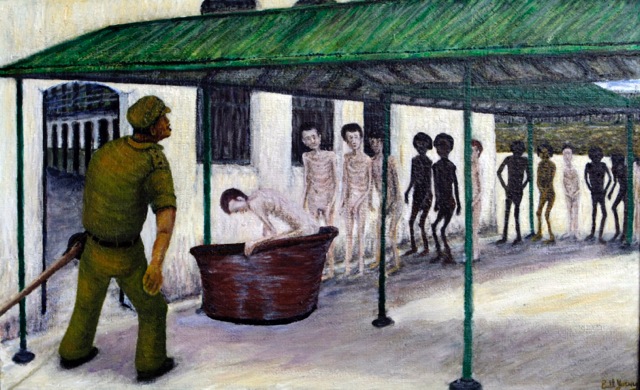
Emaciated prisoners line up in the prison yard for the indignity of the weekly scabies bath. (Painting courtesy Bill Young)
Executions took place almost daily, of Chinese civilians accused of sabotage, or even high-ranking Japanese officers accused of failing the Emperor in battle. The most honourable method of dispatch for the Japanese officers was a beheading by a Samurai sword. Hanging or death by firing squad were the alternatives.
But for those sentenced to prison terms of ten or twenty years, the Kempeitai intended them to finish their sentences, even though they were slowly starving their captives to death. The Kempeitai had a curious mentality about this, and if a prisoner did get so ill and skeletal that it seemed that they must die, a few soy beans would appear in the soup, just enough to pull them back from the brink. Otherwise there would be ‘please explains’ from higher authority.
Men, under these conditions, had to survive inside their own heads, by recalling events in their childhood, for instance, or meditation. Some, with a knowledge of Morse code managed to tap limited conversations with someone in the cell next door, but the guards were likely to hear the tapping and stop it. One Australian POW used a button from his prison issue shirt to tap his messages. The guards caught him, and then cut every button off every item of all the prisoners clothing.
There was one way out of Outram Road Gaol other than as a corpse. That was to be judged to be so ill, that death was imminent. To keep the Kempeitai books in order, they piled those who were close to death on a flat bed truck and dumped them on the ground outside the gates of Changi Gaol, the main Allied POW camp on Singapore island. Knowing that, Eric Lomax had faked a crisis by making his body shake, and his pulse race, and the prison guards were alerted. As Lomax later wrote, ‘It’s not too difficult to feign imminent death when you already look like a corpse’.
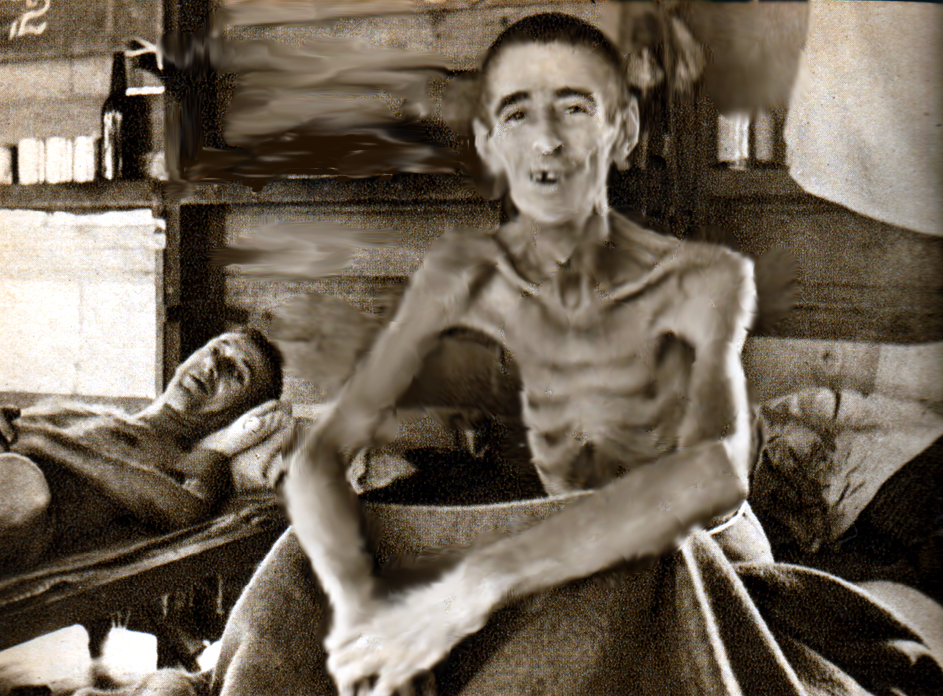
Few photos survive of just how skeletal the Outram Road Gaol survivors were when they got to Changi. This is British POW ‘Becky’ Sharpe, who is grinning because the photo was taken in the Changi Hospital and the war was over. (Photo: Illustrated London News)
Safe in the hands of the Australian doctors in Changi, who began to nurse Lomax back from the brink with a precious egg or two and vegetables and rice, his skeletal frame weighed only 47 kilos – half his normal body weight. The strategy was to keep the Outram Road patients secluded, because Japanese doctors from Outram Road were likely to make surprise visits and declare the prisoners fit to return to the gaol to resume their sentence – thoughtfully suspended in their absence. After several months, Lomax was unlucky enough to be judged fit to be returned to Outram Road Gaol, a terrible blow to his morale.
Although conditions in Outram Road by early 1945 had improved marginally – he shared his cell with a young Indonesian soldier with whom he could at least converse in a limited way – he decided to fake an accident to get himself back to Changi by tripping on some steel stairs while on toilet bucket emptying duties. He calculated that by falling 17 steps down, he could sustain the right degree of injuries without killing himself. He crashed noisily to the bottom of the stairs, in company with a stretcher load of binki buckets, and lay there pretending to be paralysed. Yet the Japanese were suspicious, and he had to feign the inability to move or eat for two whole weeks (nearly dying in the process) before he was again dumped outside the gates of Changi and managed to stay in the doctors’ care there until the sudden end of the war followed the dropping of the atomic bombs on Hiroshima and Nagasaki in August 1945.
……..
Eric Lomax decided to stay in the army on his return to Britain. Like many returning POWs who had been out of touch with his family, he caught up with some mail when his ship landed at Southampton. One, from his father, told him his mother had died three and a half years before only a month after the fall of Singapore – she died thinking her son was dead. His father had married again to a family friend that Lomax had never liked.
Three weeks after he returned to England, he married the young woman who had been his girlfriend before he went to war. Lomax knew he was taking a leap in the dark, ‘as risky as that jump on the stairs at Outram Road Gaol’. His new wife, whom he referred to as S had grown up under the certainties of a strict religious family. He felt S was the best safe haven he could have after what he considered his father’s betrayal by marrying again.
A brief army medical examination cleared him as fit, and doctor told him cheerfully to ‘get on with his life’. This was certainly more easily said than done. He was already suffering terrible nightmares during which he returned to the torture sessions with the Kempeitai on the Burma Railway, and perhaps even more vividly, that he was back and starving in his tiny cell in Outram Road Gaol. He tried to talk to S about what had happened, but she prattled on about rationing and how hard it had been for her and her family during the war. There was no way she could even begin to understand what he had been through, and he quickly realised he could not unburden himself to her. Lomax wrote:
It cannot have been easy for her – she really had no idea of what she was taking on. One of the first things she found herself doing was rubbing special cream into my infected skin. Ringworm and eczema were among my contributions to the honeymoon. I can see how hard it was, despite our later estrangement. I was broken down, her own romantic ideas were rubbed up against the reality of this nervous, pale and debilitated young man. She was as much a victim of the war as me.
As well as the nightmares, he found himself brooding of past events in the harsh light of day. A recurring theme was the brutal Kempeitai thugs who tortured him in Kanchanaburi, and the ‘hateful little interpreter with his dreadful English pronunciation, his mechanical questions and his way of being in the room yet seeming to be detached from it’.
Lomax found the army was his only safe haven. He had signed on as Signals Officer at the Edinburgh University Senior Training Corps, which was a job he could do and put off making important decisions in his private life. After his stint with the army, he joined the Colonial Service as an expert in diseases of the potato, and was posted to the emerging nation of Ghana, on the Gold Coast of Africa in 1949 where he found some fulfilment in the work he was doing there. But he decided to retire in 1956. He was 36 years old.
Unfortunately the nightmares were still haunting him, Outram Road coming back night after night. His marriage with S was still going on, and they had two daughters. But by 1981 the relationship was over.
He began to study more about the circumstances in Thailand and Singapore, and found himself fixating his hatred on the interpreter for the Kempeitai who came to symbolise the worst horrors of his past. By 1982 he had met his second wife Patti – where else but on a train – who unlike S was able to listen to his anguished stories about what had happened to him as a POW of the Japanese. He began trying to find out where the other POWs he had known were still alive, and correspond with them. One letter came from Henry Cecil Babb, of Oxford, a former padre with the 8th Division in Malays and later on the Railway, who after the war had volunteered to join an official War Gravers Commission party which travelled up the still operating Thai-Burma Railway and discovered 144 cemeteries on either side of the line, and over 10 000 bodies. A Japanese interpreter had travelled with the party, and had corresponded with him. Babb suggested to Lomax that he might like to correspond with the interpreter to find out more about what had happened on the railway.
Lomax felt that direct correspondence with a Japanese interpreter was beyond him at that stage, particularly when he heard from Babb that the man was none other than Nagase Takashi, who had been the focus of so much of his hatred.
In 1985, Babb moved to Cambridge and Lomax visited him there. Babb was old and ill, but his mind was as sharp as ever. He was able to talk more about his correspondence with Nagase, who claimed to have become active in charitable causes near Kanchanburi in the post war years and had built a Buddhist temple near the railway there. He had apparently organised a meeting of ‘reconciliation’ at the River Kwae Bridge – a famous structure featured in David Lean’s film starring Alec Guinness. Babb died in 1987 and Lomax felt unable to correspond with Nagase, feeling he would ‘rather cut off my arm’.
By now his second wife Patti was aware that her husband had been seriously psychologically damaged by his wartime difficulties, and that somehow they had to be faced – or perhaps their relationship would break down. Lomax did undertake some counselling, and found of particular value long conversations with Mrs Helen Bamber, who had set up a new organisation called the Medical Foundation for the Care of Victims of Torture in London. He began to realise that he was not crippled or mad, and that their meetings were ‘like walking through a door into an unexplored world, a world of caring and special understanding’.
Lomax still felt the need to identify the Japanese responsible for particular cruelties, but also ‘the idea of revenge was still very much alive in me’.
In 1989, Eric visited a POW friend, Jim Bradley, who had written a memoir of his own experiences, and in it gave a tribute to ‘the late Eric Lomax’. Lomax said it was a pleasure to write to Jim and tell him of his insistence on living. When they met, Bradley’s wife Linda gave Lomax a photocopy of an article from the Japan Times of 15 August 1989. The article was about Nagase Takashi. ‘As I read it, I experienced a strange, icy joy of the weirdest kind’. There was a photograph of Nagase. Behind him was a large photograph of the River Kwae Bridge. The face was unsmiling, thin and familiar with pain, the face of an ailing 71-year-old man.
The article described how Nagase had devoted much of his life in ‘making up for the Japanese Army’s treatment of prisoners of war’, an account of his war service, and how he had been seconded to the War Graves Commission exploration of cemeteries along the Thai-Burma Railway. The article also described his ill-health, his recurrent heart disease, and how every time he suffered a cardiac attack ‘he had flashbacks of Japanese military police torturing a POW who was who was accused of having a map of the railway’.
For the next two years, Lomax wondered what he might do about Nagase, because he still wanted to make Nagase suffer and thought he might like to surprise him with a surprise confrontation to make him confront him with the consequences of his actions. A documentary filmmaker offered to travel with him to record this confrontation, but Lomax held back. In July 1991 he had a meeting with a Japanese historian, Professor Nakahara Michiko, who spoke perfect English and had researched and written books about the Japanese treatment of the romusha as they called the POWs and impressed workers, during the war. At that time he was also given a small book actually written (in Japanese) by Nagase, titled Crosses and Tigers. Shortly afterwards he learned that an English edition had been published in Thailand, and ordered a copy.
Lomax read Nagase’s account of his experiences with fascination, and was electrified to read a blow-by-blow description of his torture by the Kempeitai, and Nagase’s anguish at what had taken place, and how that incident in particular – plus his experiences with the War Graves Commission revealing the enormity of the casualties from the Thai-Burma Railway – had motivated him to devote his life to apologising for the militarists and trying to help some of the victims in Thailand.
Patti Lomax also read the small booklet, and asked her husband’s permission to write to him revealing that Eric Lomax was the prisoner he had written about, and asked if he would be willing to correspond with him.
Nagase replied immediately, and ended his letter:
… please tell your husband that if I am a bit useful for him to answer my questions that he has had in his mind, I am willing to answer them.
Anyhow, I am beginning to think that I should see him again. Looking at the picture, he looks healthy and tender gentleman, though I am not able to see the inside of his mind. Please tell him to live long until I can see him.
Most sincerely yours,
Nagase Takashi
PS…the dagger of your letter thrusted me into my heart to the bottom.
Both Patti and Eric Lomax thought this a most moving and beautiful letter. Lomax felt his anger draining away, to be replaced by a welling of compassion for both men, coupled with a deep sense of sadness and regret. ‘In that moment I lost whatever hard armour I had wrapped around me, and began to think the unthinkable – that I could meet Nagase face to face in simple good will.’
********
IF YOU HAVE ANY COMMENTS TO MAKE ON THIS ARTICLE OR ANY ASPECT OF THIS BLOG, PLEASE USE THE CONTACT BUTTON UNDER THE HEADER BAR

